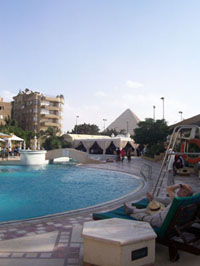TABLE
OF CONTENTS
|
Mother of the World
By Jane Wiseman

Egyptians call Cairo
the “Mother of the World”, and after visiting the bustling city I can
see why.
With such a variety of things to do and places to see, there really is
something for everyone. I took a picture from the pool at the Le
Meridien
Pyramids Hotel in Cairo
and it really
embodied the sense that there was something here for everyone. I was
standing
in this magnificent hotel with a gorgeous pool at my feet, a hookah bar
to my
left, a drink bar to my left, and in front of me, just over the
boundaries of
the hotel walls I could see the mighty pyramids towering above the
city. It
made me think of Farha Ghannam's chapter called "Relocation
and
the Creation of a Global City" in which she talks about the fact
that Cairo
is such a hodge-podge of vernacular and transnational entities. The
single
picture I took really embodies the message I got from her article.
While I
enjoyed the magnificent view from my hotel and basked in awe that I was
actually looking at the pyramids, I also thought of the article we read
at the
beginning of the semester by Eric Darton entitled "The Janus Face of
Architectural Terrorism: Minoru Yamaskai, Mohammad Atta, and Our World Trade Center."
Darton talked
about the fact that for these transnational structures to be built,
everything
from World Trade Centers to grandiose hotels, something vernacular must
be
destroyed. I wondered what might once have been where my hotel now
stood. What
had to be destroyed so that I could travel across the world and have
this magnificent
view?
Another thing I saw while in Cairo
that supports the idea that it is the “Mother of the World” is the
slums of Cairo.
Even though people know how crowded Cairo
is, people are still flocking to the city to find work that eldues them
in the countryside. There is a massive lack of housing
and
people are forced to live anywhere they can. One example of this and a
place
that we talked about in class is The City of the Dead. As well as being
a cemetery,
The City of the Dead is home to hundreds of thousands of Egyptians who
are
living in the tombs because they have absolutely no where else to live.
Although living there is nothing to brag about and those that do live
there hardly
ever talk about it, the sheer fact that people feel the need to live
there shows
the desperation to obtain housing. The fact that people are willing to
live in
a cemetary demonsrates the draw that Cairo
has. People are willing to live in a cemetery just to be able to live
in the
city. Cairo
must truly be the Mother of the World if people are willing to live in
tombs as
a way to be in the center of the action.
There is a stark contrast between
the hotel I
stayed at and The City of the Dead. And yet, both coexist a few short
miles form one another. Both the transnational hotel and vernacular
cemetery show the extremes between transnational and vernacular that I
found in Cairo.
If
nothing else, this exemplifies that Cairo
is a Global
City.
It has to deal with both ends of the transnational spectrum, both good
and bad.
|

